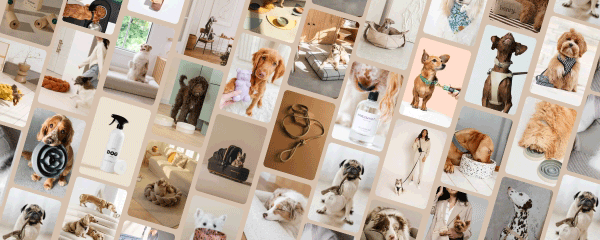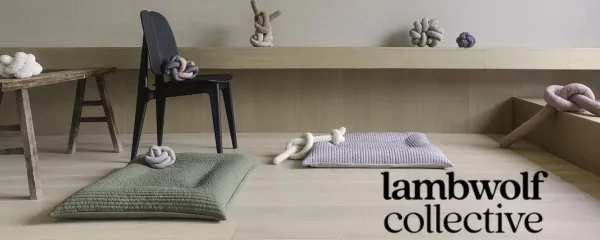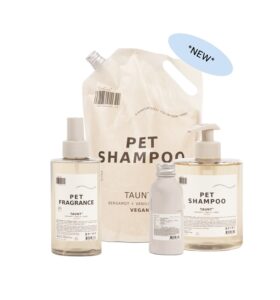Why Do Dogs Lick Their Paws and How to Stop it

Press the 'paws' button on paw licking for good with these solutions and natural remedies.
Is the sound of your dog incessantly licking their paws becoming all too familiar? If your dog won’t stop licking or chewing their paws, don’t worry – we’ve got a list of solutions for this common behaviour!
Excessive paw licking and chewing can stem from various underlying issues, but identifying the root cause of paw licking is the first step toward finding a remedy that works for your dog.
Here we’ll explore a range of effective solutions to help curb this habit, including natural home remedies to stop paw licking if you prefer an all-natural approach.
Why Do Dogs Lick Their Paws? 6 Reasons Explained
1. Allergies
Allergies are the most common cause of excessive paw licking in dogs. And just like humans, dogs can be allergic to many things – food allergies, environmental allergies, and contact allergens are the most common types.
When it comes to food allergies in dogs, proteins like chicken or beef are the most common culprits (though carbs, preservatives, or dyes can also trigger reactions). If your dog has food allergies, switching to a limited ingredient or raw food diet is often recommended.
Environmental and seasonal allergies in dogs include allergic reactions to pollen, mold spores, dust mites and grass. These allergens cause itching, redness, sneezing, watery eyes, and ear infections.
Dogs with environmental allergies can also experience frequent paw licking or biting, and some may develop skin infections or hot spots from constant irritation. According to this report, environmental allergies in dogs are increasing.
Dogs can also become allergic to things they come into direct contact with, like certain chemicals, fabrics, detergents and grooming products.
2. Yeast infections
You’ll certainly know if your dog has a fungal yeast infection. Aside from the itchiness, you won’t be able to miss the yucky smell!
The overproduction of yeast is a source of infection which causes irritation and excessive paw licking. The warm, moist areas between paw pads are a common breeding ground for yeast to develop.
When dogs lick their irritated paws, it can lead to secondary bacterial infections, which can exacerbate the irritation and create a cycle that typically requires anti-fungal treatment to manage.
Yeast infections can also hint at an underlying weakness in your dog’s immune system, so it’s important to determine the root cause. If your dog does have a yeast infection, it’s also likely a sign your dog needs probiotics in their diet.

3. Separation anxiety or boredom
Another common reason why dogs lick their paws is due to boredom or stress. If your dog is suffering from boredom, they may start licking their paws simply to entertain themselves.
Separation anxiety can also cause a dog to lick their paws, along with other destructive behaviours such as barking or chewing furniture. Dogs may lick their paws as a way to soothe themselves when they’re waiting for you to come home.
Certain breeds are more prone to anxiety, such as separation anxiety or obsessive-compulsive behaviours, and licking their paws can become a coping mechanism to help them self-soothe.
4. Pain, injuries or arthritis
Dogs can also lick their paws as a way to relieve themselves from pain.
If your dog has an injury or is suffering from arthritis, it’s likely they’ll have a strong instinct to lick and clean their wounds in an attempt to ease the pain.
You might notice that the affected area appears red or swollen, and your dog may shy away from letting you examine it out of distress. This behaviour can also signal they’re trying to draw attention to the discomfort, so it’s important to keep an eye on any changes in their licking habits or physical condition.

5. Parasites
Fleas, ticks, and mites are another common reason dogs develop compulsive licking, chewing, or scratching habits.
While ticks are usually easy to spot, fleas often remain hidden until an infestation is severe, and mites are too tiny to be seen without a microscope. So, even if you can’t see any parasites, that doesn’t mean your dog isn’t dealing with them!
Parasites can cause skin reactions in dogs that range from mild to severe, with symptoms including pimples, hives, crusting and excessive paw licking.
6. Dry skin
Your dog’s paw licking could also be due to dryness or other skin conditions like hot spots. When paw pads become dry, they can feel irritated and may even crack without the use of a moisturiser or balm.
Dry skin on your dog can be caused by a number of things, such as bathing too long, cold and dry weather (notorious for causing dry skin in dogs and humans alike!) and can even be a breed-specific issue.
If your dog has dry and flaky skin, it’s likely to become itchy and cause your dog to start licking in an attempt to relieve the itchiness and discomfort.
Dog Licking Their Paws? 11 Remedies to Try

Medicated dog shampoos & topical treatments
If your dog is licking their paws due to allergies or bacterial infections, topical treatments such as sprays or creams containing hydrocortisone, or medicated dog shampoos such as Pet Honesty’s Chlorhexidine in the U.S can be effective in restoring a healthy balance of organisms on your dog’s skin.
Allergies can be difficult to diagnose and treat however, so it’s best to talk to your vet to identify the source of your dog’s allergy and prescribe the best treatment plan.
Change their diet
Excessive paw licking can be caused by the over-production of yeast in your dog’s body.
A common cause of yeast infections are food-related allergies. So it might be time to look closely at your dog’s diet and speak to your vet about the best course of action, such as switching to a raw dog food diet or a brand of anallergenic kibble.
TIP: If your dog suffers from food allergies, we highly recommend Royal Canin Anallergenic Dry Food. Our cocker spaniel, Ziggy, experienced frequent yeast infections for years before switching to this diet which helped to resolve his allergies. Always consult with your vet before changing your dog’s diet.

Bathing & paw balms
If your dog’s paws are dry and cracked, a daily bath will help to soothe and soften their skin. You can try a pet-formulated, high-quality dog shampoo or a gentle baby shampoo.
After bathing your dog, be sure to dry their paws thoroughly to help prevent cracking and infection, particularly between the toes. Once your pup is dry, apply a soothing natural paw balm to lock in the moisture.
Boredom busters & exercise
If your dog is licking their paws because they are bored or anxious, it’s likely they need more mental stimulation and exercise to alleviate this behaviour. Compulsive behaviours like biting, chewing, or paw licking can sometimes stem from fear, stress, or lack of stimulation. To help prevent these issues, ensure your dog gets plenty of exercise, attention, and love.
Walking your dog for at least 30 minutes every day, or trying these dog enrichment ideas when they are left alone, will go a long way in easing their anxieties and keeping them happy and occupied.
Training your dog to focus on chewing toys or bones can also provide a positive outlet for stress, which can help to curb unwanted chewing or paw licking habits.
Eliminate parasites
If your dog is licking their paws due to a tick or parasite, there are several flea and tick products that your veterinarian can suggest.
To further address the issue, it’s essential to regularly wash your dog’s bedding and vacuum your carpets and upholstered furniture to minimise the risk of re-infestation. Don’t forget to treat any other pets in your home as well!
Try a bandage or socks
A simple remedy to stop your dog from licking its paw is by fitting a bandage or sock.
It may take a little patience, but if you cover your dog’s paw with a light bandage and let them wear it for a few days, you may find that your dog will stop licking their paw.
For some dogs, bandaging their paw is enough to prevent them from licking – out of sight, out of mind after all!

Natural Home Remedies to Stop Paw Licking
If you would prefer to try a natural home remedy to relieve the itch and irritation behind your dog’s paw licking, the following all-natural solutions can be effective, depending on the root cause of your dog’s constant licking:
Chamomile Tea
Chamomile is well-known for its soothing anti-inflammatory properties, so it’s no wonder it’s an effective natural home remedy to relieve your dog’s paw licking too. Plus, its antimicrobial qualities can help to prevent infections that can potentially arise from excessive scratching.
There are a few ways chamomile tea can be used to alleviate the itch that is causing your dog to lick their paws – a chilled tea compress, bath soak or spray.
Oatmeal bath
An oatmeal bath can offer quick relief for an itchy dog. Thanks to its soothing and anti-inflammatory properties, oatmeal serves as an effective natural treatment for your pup’s scratching.
Just grind plain oatmeal into a fine powder, add it to a warm bath, and allow your dog to soak for 15-20 minutes. This soothing soak will help calm irritated skin and ease your dog’s itching.
Apple Cider Vinegar
‘Can I put vinegar on my dog’s paw to stop their licking?’ is a common question pet parents ask.
The answer is yes, diluted apple cider vinegar can be an effective home remedy to stop your dog licking their paws. Just remember to avoid applying it directly on any broken skin, as it may sting and cause discomfort. It’s also important not to apply vinegar near your dog’s ears, eyes, or genital area.
For a gentle application, mix equal parts apple cider vinegar and water in a spray bottle, then lightly mist your dog’s paws.

Coconut oil
Coconut oil isn’t just a trendy ingredient for us humans – it’s also a great solution for dogs!
With its moisturising and soothing qualities, applying coconut oil to your dog’s paws can effectively ease dryness and itching, and ultimately the constant paw licking. Plus, it helps keep their coat looking shiny and healthy.
Be sure to use virgin, unrefined coconut oil, and start with a small amount to gauge how your dog’s skin reacts. You can also incorporate coconut oil into your pup’s diet with these homemade dog treats.
Baking soda
Yes, this common kitchen ingredient is actually a natural anti-inflammatory and acid neutraliser that can help alleviate your dog’s irritated paws and skin.
Simply mix 1/2 cup (120 ml) of baking soda into a bucket of warm water and let your dog soak their paws for 10 minutes. For best results, repeat this process 2 to 3 times daily.
To keep your pup occupied during the soak, consider giving them some dog treats. If your dog is larger or more energetic, you can soak their paws in a bathtub, and don’t hesitate to double the baking soda mixture if needed.

When to be concerned about paw licking
If your dog can’t stop licking their paws and you’re worried it might point to a more serious issue, here’s a list of warning signs to watch out for:
- Lick granulomas: a persistent skin condition triggered by constant paw licking
- Limping: this could indicate something stuck in their paw, like a grass seed
- Red paws: redness and irritation between the toes or pads
- Bleeding: licking paws to the point of bleeding is a red flag
- Visible signs of injury or infection
If your dog is experiencing any of these symptoms, it’s best to schedule a vet visit right away.
Need to speak to a vet now?

Talk to a licensed veterinarian in minutes with Vetster, the top-ranked pet health app available 24/7.
Get professional guidance and receive a care and treatment plan, right from the comfort of your home.
It’s quick, convenient, and trusted by pet parents everywhere.
Pretty Fluffy is the ultimate lifestyle destination for dog lovers. Discover the best designer dog brands and emerging small pet businesses, the latest dog accessories, healthy dog treat recipes, dog training tips and more. Thank you for being part of our dog-loving community!









